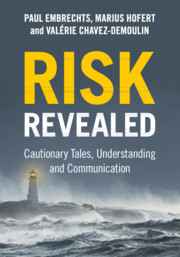Refine search
Actions for selected content:
84 results
5 - Nobody Is Spared
-
- Book:
- From Crisis to Action
- Published online:
- 15 August 2025
- Print publication:
- 04 September 2025, pp 93-110
-
- Chapter
-
- You have access
- Open access
- HTML
- Export citation
Preliminary Report on Symptoms of Anxiety, Depression, and PTSD Following Severe Flooding in Brazil: A Longitudinal Perspective
-
- Journal:
- Disaster Medicine and Public Health Preparedness / Volume 19 / 2025
- Published online by Cambridge University Press:
- 16 July 2025, e189
-
- Article
- Export citation
Chapter 3 - Turbulent Worlds
-
- Book:
- Ovid and Plato
- Published online:
- 19 June 2025
- Print publication:
- 03 July 2025, pp 43-60
-
- Chapter
- Export citation
The Bayesian Network Model Revealed the Hospital Decision-making Rationale for Flood Evacuation Planning
-
- Journal:
- Disaster Medicine and Public Health Preparedness / Volume 19 / 2025
- Published online by Cambridge University Press:
- 25 June 2025, e163
-
- Article
- Export citation
Impact of Hurricanes and Floodings on Mental Health Outcomes Within the United States: A Systematic Review and Meta-Analysis
- Part of
-
- Journal:
- Disaster Medicine and Public Health Preparedness / Volume 18 / 2024
- Published online by Cambridge University Press:
- 03 January 2025, e335
-
- Article
- Export citation
The Self-Reported Human Health Impacts of Disaster on People in India: A Cross-Sectional Analysis of the Longitudinal Aging Study India
-
- Journal:
- Prehospital and Disaster Medicine / Volume 39 / Issue 6 / December 2024
- Published online by Cambridge University Press:
- 03 February 2025, pp. 402-414
- Print publication:
- December 2024
-
- Article
- Export citation
4 - Dynamic Hazard Modelling
- from Part II - Advanced CAT Modelling
-
- Book:
- Introduction to Catastrophe Risk Modelling
- Published online:
- 08 November 2024
- Print publication:
- 21 November 2024, pp 161-192
-
- Chapter
- Export citation
1 - An Inexhaustible Source of Power
- from Part I - Starting from Scratch
-
- Book:
- Hydropower Nation
- Published online:
- 24 October 2024
- Print publication:
- 07 November 2024, pp 25-47
-
- Chapter
- Export citation
Exploring the Association Between Floods and Diarrhea among Under-five Children in Rural India
-
- Journal:
- Disaster Medicine and Public Health Preparedness / Volume 18 / 2024
- Published online by Cambridge University Press:
- 24 October 2024, e142
-
- Article
- Export citation
Turn Around, Don’t Drown: A Systematic Review of Risk Factors for Motor Vehicle–Related Drowning in Floods and its Preventive Strategies
-
- Journal:
- Disaster Medicine and Public Health Preparedness / Volume 18 / 2024
- Published online by Cambridge University Press:
- 18 September 2024, e134
-
- Article
- Export citation
Health Consequences Management in a Multi-Hazard Context: A Systematic Review of the Coincidence of Flood and the COVID-19 Pandemic – CORRIGENDUM
-
- Journal:
- Disaster Medicine and Public Health Preparedness / Volume 18 / 2024
- Published online by Cambridge University Press:
- 11 July 2024, e100
-
- Article
-
- You have access
- HTML
- Export citation
Health Consequences Management in a Multi-Hazard Context: A Systematic Review of the Coincidence of Flood and the COVID-19 Pandemic
-
- Journal:
- Disaster Medicine and Public Health Preparedness / Volume 18 / 2024
- Published online by Cambridge University Press:
- 02 May 2024, e84
-
- Article
- Export citation
1 - The 1953 Great Flood
-
- Book:
- Risk Revealed
- Published online:
- 05 April 2024
- Print publication:
- 11 April 2024, pp 1-12
-
- Chapter
-
- You have access
- Export citation

Risk Revealed
- Cautionary Tales, Understanding and Communication
-
- Published online:
- 05 April 2024
- Print publication:
- 11 April 2024
Development of Flood Preparedness Behavior Scale: A Methodological Validity and Reliability Study
-
- Journal:
- Prehospital and Disaster Medicine / Volume 39 / Issue 2 / April 2024
- Published online by Cambridge University Press:
- 25 March 2024, pp. 123-130
- Print publication:
- April 2024
-
- Article
-
- You have access
- Open access
- HTML
- Export citation
Introduction
-
- Book:
- Stories of Origins in the Bible and Ancient Mediterranean Literature
- Published online:
- 23 December 2023
- Print publication:
- 07 December 2023, pp 1-38
-
- Chapter
- Export citation
Exploring suicidality in the aftermath of the 2022 flood in Pakistan: insights from newspaper reports
-
- Journal:
- CNS Spectrums / Volume 29 / Issue 1 / February 2024
- Published online by Cambridge University Press:
- 15 August 2023, pp. 1-3
-
- Article
-
- You have access
- HTML
- Export citation
7 - Data Assimilation in Hydrological Sciences
- from Part II - ‘Fluid’ Earth Applications: From the Surface to the Space
-
-
- Book:
- Applications of Data Assimilation and Inverse Problems in the Earth Sciences
- Published online:
- 20 June 2023
- Print publication:
- 06 July 2023, pp 112-130
-
- Chapter
- Export citation
Do natural catastrophic events and exceptional climatic conditions also affect parasites?
-
- Journal:
- Parasitology / Volume 150 / Issue 12 / October 2023
- Published online by Cambridge University Press:
- 15 May 2023, pp. 1158-1166
-
- Article
-
- You have access
- Open access
- HTML
- Export citation
Effectiveness and cost of a rapid response campaign against Japanese knotweed (Reynoutria japonica) along a Canadian river
-
- Journal:
- Invasive Plant Science and Management / Volume 16 / Issue 2 / June 2023
- Published online by Cambridge University Press:
- 30 March 2023, pp. 124-129
-
- Article
-
- You have access
- Open access
- HTML
- Export citation
